*This post may contain affiliate links. Read more »
This vegan biryani recipe is an absolute feast for the senses. As you spoon the fragrant basmati rice onto your plate, you'll soak up the aromatic herbs and the colorful mélange of tender vegetables nestled within. Whether you're a lifelong vegan or just looking for a meat-free meal, this biryani is sure to satisfy.
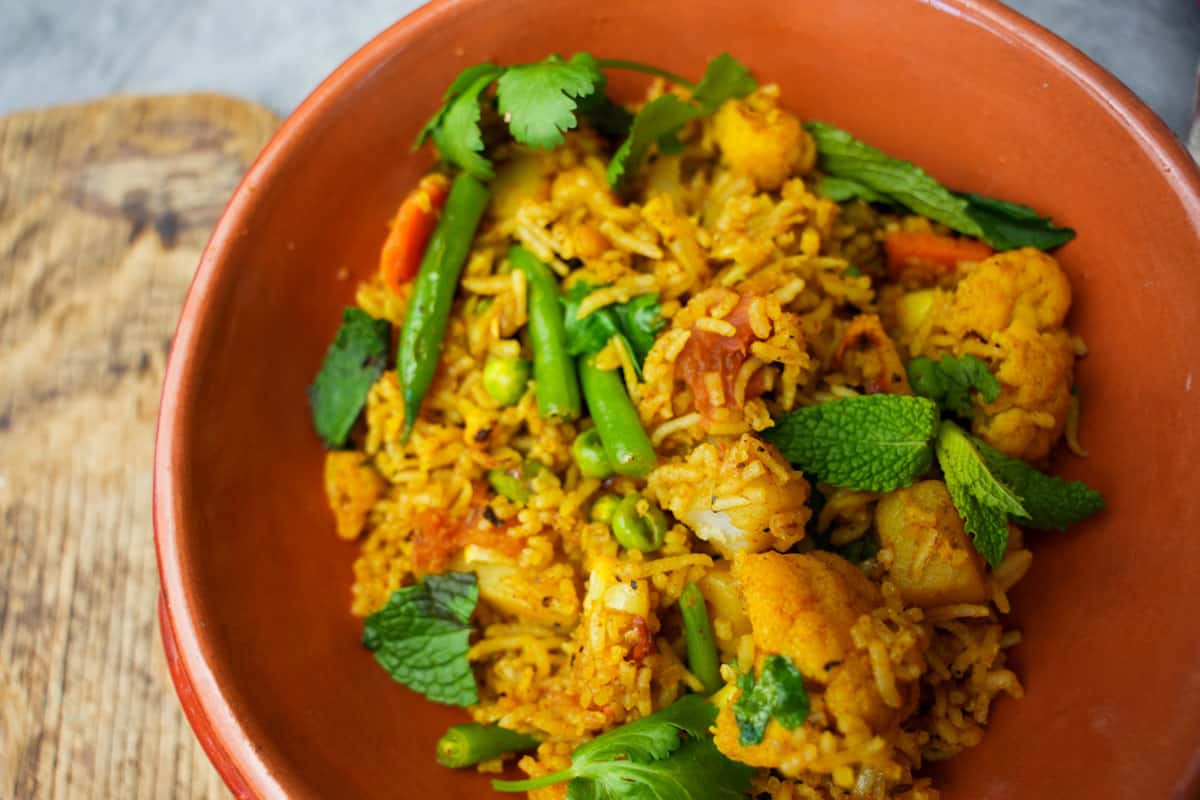

Enter your email & I'll send it to your inbox. Plus, get great new recipes from me every week!
By submitting this form, you consent to receive emails from Cinnamon Snail.
My vegetable biryani recipe is not only completely sattvic, and packed with flavor from a mix of ground and whole spices, but also features a balance of nutritious vegetables and herbs. The dish includes a medley of veggies, such as string beans, carrots, potatoes, peas, and cauliflower, that add both texture and color to the dish. The spices are complemented by fresh herbs like cilantro, curry leaves, and mint, which not only add freshness, and aroma but also provide medicinal benefits. Want to build a complete meal around this? Serve it with my dreamy, easy-to-make red lentil dahl, Punjabi Chana Masala, or onion bhaji.
Whether you're trying to incorporate more plant-based meals into your diet or simply looking for a new flavor sensation, this vegan biryani is going to make you super happy!
Jump to:
- 🥰Why you are going to adore the ever-loving heck outta this recipe
- 🧈Recipe Ingredients and Subsitutions
- 🤯Some different styles of veg biryani you might want to try
- 📖 How to make perfect Vegan Biryani
- 🍽️Serving Ideas
- ❗️Top tips
- 🤷♀️Recipe FAQs
- ✌️Other Indian dishes that go great with this:
- Hyderabadi Veg Biryani (Easy Restaurant Style Rice Recipe)
🥰Why you are going to adore the ever-loving heck outta this recipe
🌿Sattvic Satisfaction: No onions, no garlic, no mushrooms – a perfect match for your sattvic lifestyle.
🌿 Nutrient Powerhouse: Packed with veggies, fiber, and healthy fats, this biryani is a satisfying and nutritious delight.
🚫 Allergen-Free Wonder: Gluten-free, dairy-free, soy-free, and sugar-free – a recipe that caters to various dietary needs.
🍚 Leftover Magic: Like my crispy rice dumplings, tom yum fried rice, and khao pad, this veg biryani recipe transforms plain rice leftovers into a flavorful encore. Don't let your plain leftover rice go to waste!


🤘learn to make insanely flavorful vegan sides
This guide to my most popular vegan side dishes is 100% FREE, & you'll love the actual heck out of it 🥰
🧈Recipe Ingredients and Subsitutions
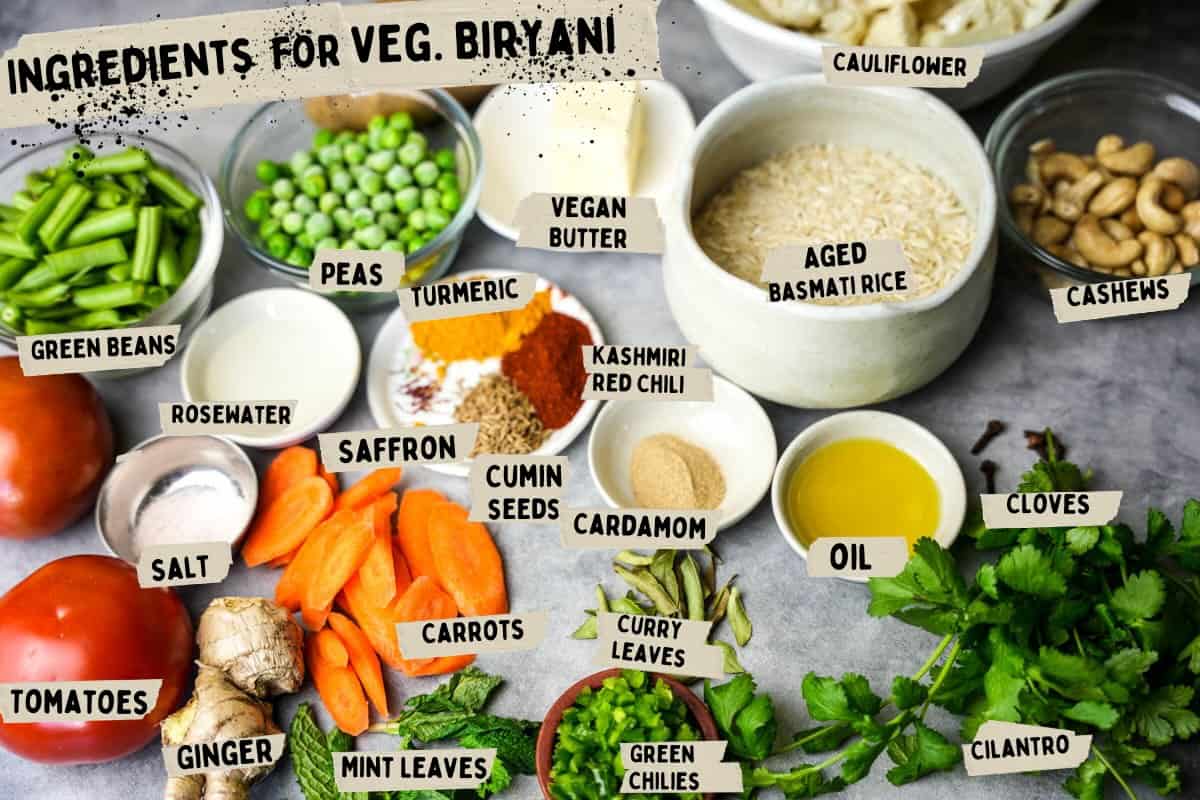
Aged basmati rice
Aged basmati rice is a premium variety of long-grain rice that has been stored for at least a year to enhance its flavor and aroma. During the aging process, the moisture content of the rice decreases, resulting in a firmer texture and distinct nutty flavor. Aged basmati rice is prized for its long, slender grains that cook up fluffy and separate, making it a popular choice for biryanis, pilafs, and other rice dishes. You can TOTALLY use regular ol’ basmati rice and even a variety of other (non-basmati) rices entirely.

Get my fave cumin seeds for free!
Using this link, add the wild mountain cumin to your cart, spend at least $15 on some of the other absurdly good spices from Burlap & Barrel (they all seriously slap) and the bottle of this bangin' wild mountain cumin becomes FREE, and you will love it so much.

Kashmiri red chili powder
Kashmiri red chili powder is known for its vibrant red color and mild heat, with a subtle fruitiness and smokiness. It is often used to add color and flavor to dishes such as tandoori chicken (I use it in my vegan butter chicken), rajma masala, and aloo gobi recipe too. If you can’t get any, a mild paprika can stand in for it, maybe with a tiny little bit of cayenne added to it if you would like it to be on the spicier side.
Cardamom
Both powdered green cardamom or even smoked black cardamom work great in this recipe!
Rose Water
In this recipe, rose water is delicately introduced to infuse a subtle floral note, adding a unique and aromatic dimension to the biryani. If you have any leftover, you should make this flaky baklava with it!
Curry Leaves
Curry leaves are an aromatic herb commonly used in Indian cuisine, especially in some regions of South India. They have a pungent flavor, and otherworldly, delicious aroma and are often used to add depth and complexity to dishes like soya chaap, and phool makhana sabji. You can find them for sale at most Indian grocery stores. I have found that you can buy a couple bags of the fresh leaves and freeze them. While they aren’t 100% quite as vibrant that way, they still lend their fragrance and flavor to dishes for a couple of months after being frozen.
Green Beans
You can really use any kind of green bean you like for this recipe. My top choices would be string beans (what you would use in making urap sayur), runner bean (what you would make Zeytinyağlı Taze Fasulye Tarifi with) or long beans (what you would use in adobong sitaw and sambal goreng)
Saffron
Saffron is a spice derived from the stigma of the crocus flower and is one of the most expensive spices in the world due to the labor-intensive process required to harvest it. Luckily you need just the tiniest pinch of it in this recipe.
See the recipe card at the bottom of this page for the complete list of ingredients and their quantities.
🤯Some different styles of veg biryani you might want to try
- Thalassery style biryani: This is a biryani from the coastal town of Thalassery in Kerala, South India. It is made with a short-grain rice called jeerakasala instead of basmati, but follows the same cooking method. You can approximate the Keralan flavor by adding a teaspoon of fennel seeds, a cinnamon stick, and doubling the amount of cloves to the rice when it is initially cooking. Serve it with clasic dishes from Kerala like aviyal, olan, and parotta.
- Vegan Hyderabadi Biryani: This is a famous biryani from the city of Hyderabad (home of Juno.com, the email provider from the 90’s that my wife still used until a couple years ago). It is normally made with basmati rice, meat (usually chicken or lamb), and a blend of spices that includes saffron, mint, and cinnamon. You can replace the meat by adding 1 ½ cups of chopped seitan to the pot when you are frying the cashews and cauliflower. I like to sauté it for long enough for the seitan to brown a little bit on all sides so it has a satisfying meaty mouthfeel.
📖 How to make perfect Vegan Biryani
You wanna see how this yummy stuff gets made? I will walk you through the whole process. Or you can follow along with the easy-to-print recipe card towards the bottom of this page.
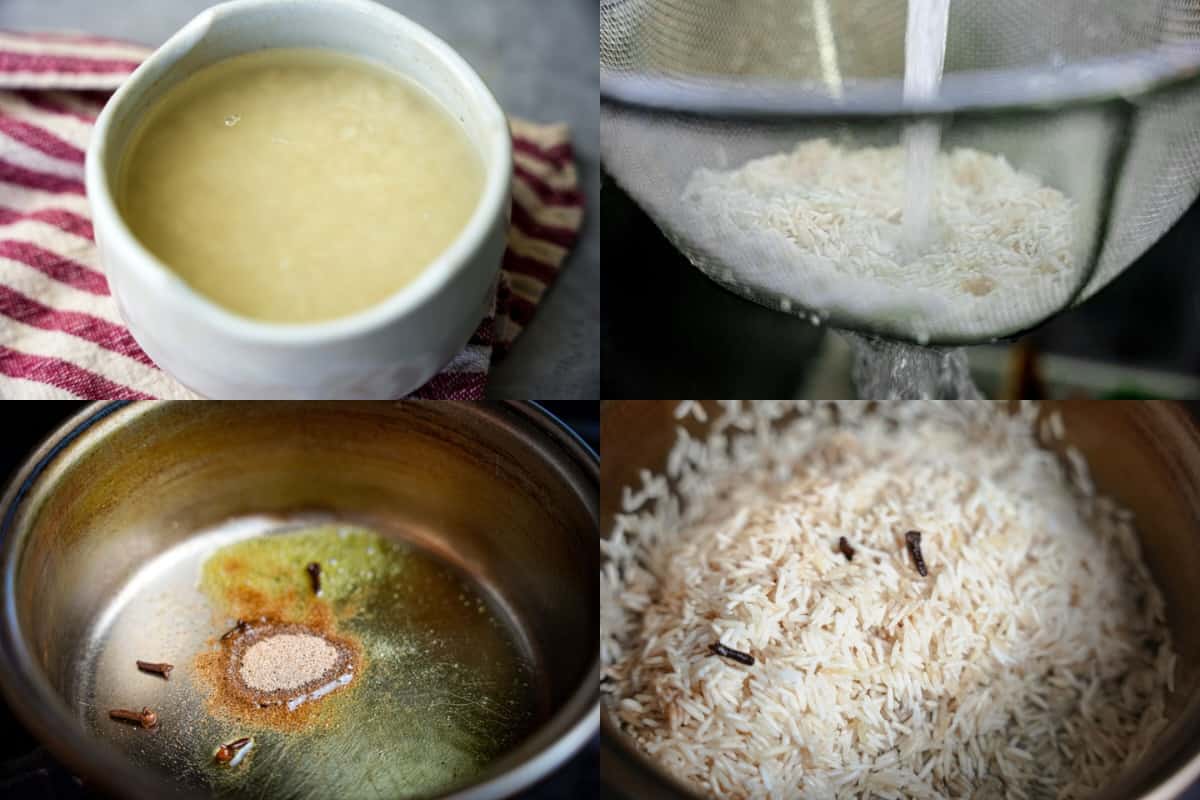
Step 1
Begin by soaking the rice in plain water for 20-30 minutes.
Step 2
After the rice has soaked, rinse it in a mesh strainer under cold running water to remove any excess starch. Allow the rice to drip dry.
Step 3
Next, heat a saucepan with 1 tablespoon of oil over medium-high heat. Once the oil is hot, add the whole cloves and cardamom and fry for 30 seconds.
Step 4
Add the drained rice to the saucepan and sauté for 60 seconds, constantly stirring to lightly toast the rice in the hot oil. Some people like to add a bay leaf here too.
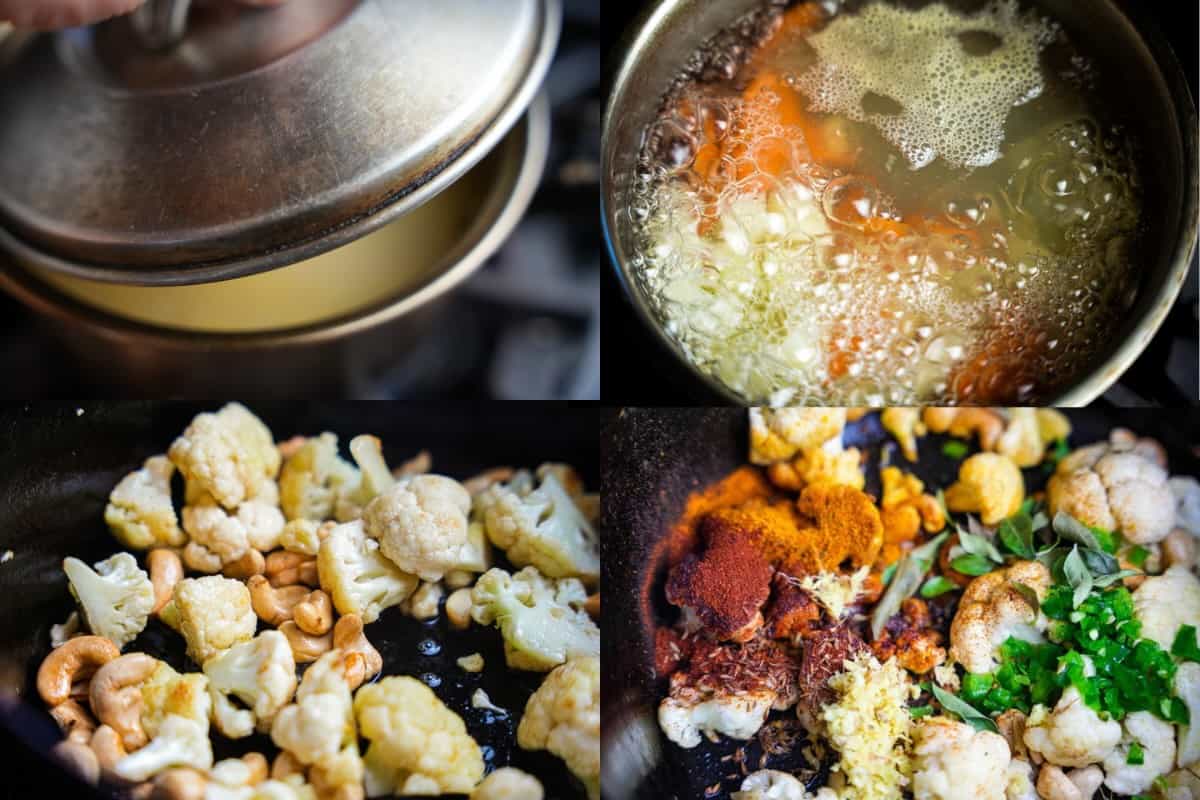
Step 5
Add water to the saucepan and cover it. Once the water comes to a boil, reduce the heat to low and allow the rice to steam for 15-20 minutes, until it is fully cooked and all the water has been absorbed.
Step 6
While the rice is cooking, boil diced potatoes and carrots in a separate pot over high heat until they are fork-tender, which should take about 12-14 minutes. Once cooked, drain them in a colander.
Step 7
In a dutch oven, melt vegan butter over high heat until it is bubbling. Add cashews and cauliflower and sauté them for 3-4 minutes until they are lightly golden brown.
Step 8
Lower the heat to medium and stir in the spices, chilies, curry leaves, ginger, and chilies.
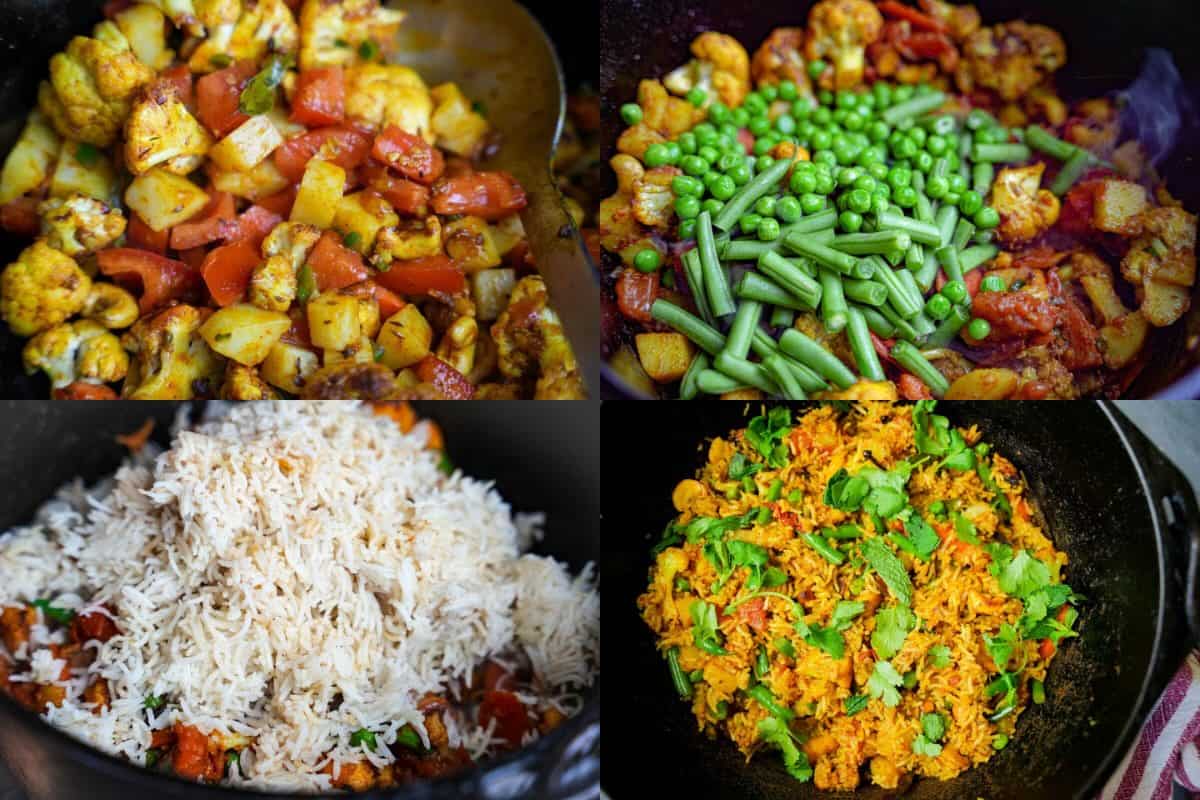
Step 9
After two minutes, add the tomatoes and pre-cooked potatoes and carrots. Sauté for 4 minutes over medium heat, stirring constantly.
Step 10
Add the peas and string beans and sauté for another 2 minutes until the string beans are just tender.
Step 11
Mix in the cooked rice, rosewater, and salt, and make sure to break up any clumps of rice so that the vegetables and seasonings are fully distributed, and the rice becomes a lovely shade of golden orange.
Step 12
To serve, garnish the dish with fresh cilantro and mint leaves. Serve with your favey Indian pickles such as hari mirch achar, gajar ka achar, or pickled amla.
🍽️Serving Ideas
This biryani is absolutely heavenly paired with other classic sabjis like saag aloo, beerakaya, arbi sabji, lauki sabji, ridge gourd curry, or sattvic parval sabji.
Want something meaty (that's still veg) to serve on this? My kathal ki sabji could totally fool your meat-loving friends.
This is also great to simply eat with some steaming hot chana dal, freshly grilled kuboos, or chur chur naan.
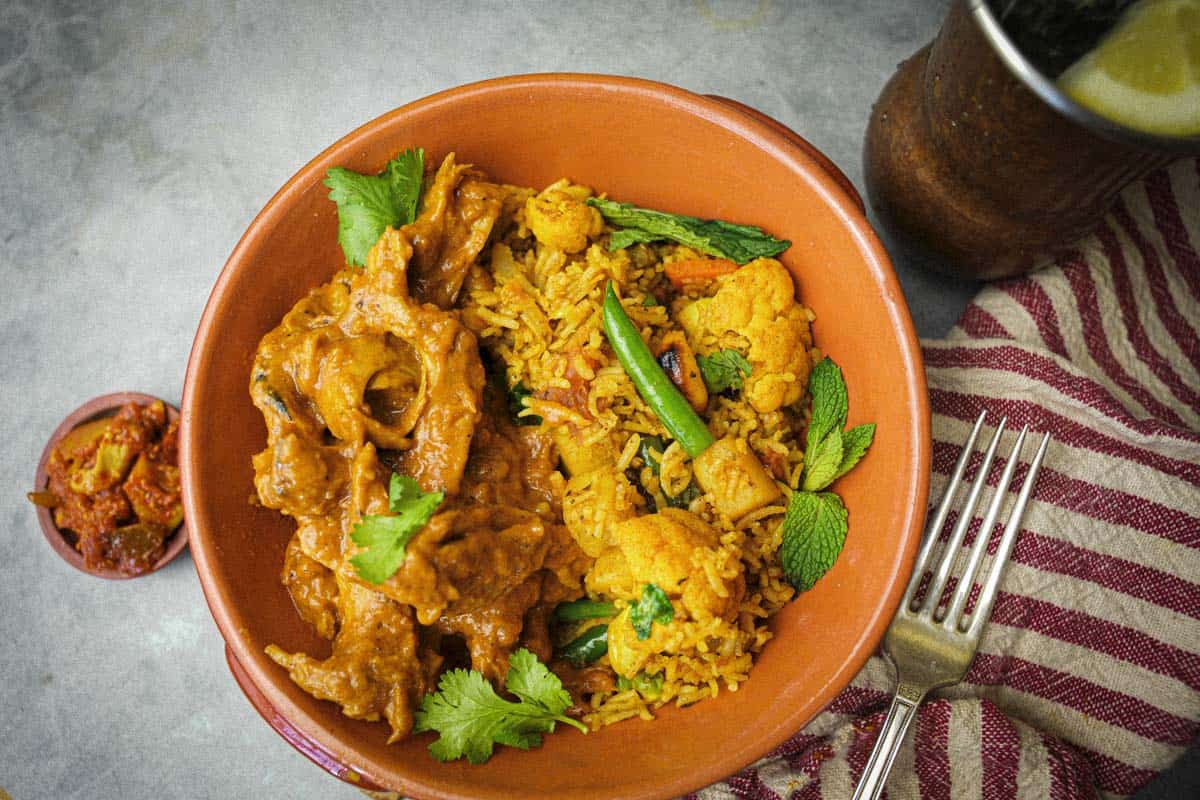
❗️Top tips
For sure don’t skip soaking and rinsing your rice! One of the divining features of expertly cooked biryani is the individuality of the grains of rice. Great biryani is never clumpy or stuck together. The way to make that happen is to start with good quality basmati rice (ideally aged, extra-long grain), and then soak it for 20-30 minutes in cold water. Then rinse under cold water until the water runs clear to remove extra starch. The starch is what causes the rice to clump together.
🙏If you are following a sattvic lifestyle, I hope you will not taste the food while cooking it (just trust my recipe!) and make a bhoga offering of the food adorned with Tulasi leaves before you honor it as prasadam. If you don’t know what I am talking about here, this tip is not for you!

🤷♀️Recipe FAQs
Veg biryani can be vegan if it's made with only plant-based ingredients. However, it's important to note that some traditional biryani recipes may contain ghee (clarified butter), which is an animal product. So, if you're following a vegan diet, it's important to confirm with the person making the biryani that it's free from any animal-based ingredients.
Some pre-made biryani masala or mixes may contain gluten, so reading the ingredients carefully is important. This biryani recipe is completely gluten-free!
Yes, you can use brown rice instead of white rice in veg biryani. However, brown rice will take longer, and require about 30% more water to cook, so adjust the cooking time accordingly.
Biryani is a dish with a long and complex history, with roots in the Indian subcontinent dating back over 400 years.
Some historians believe that biryani was brought to India by the Mughals, who ruled India from the early 16th to the mid-19th century. It's said that the Mughal emperors enjoyed lavish feasts. A rice dish made with ghee and spices was documented, so it is thought that biryani was one of the dishes that was served at these banquets. Over time, biryani became a popular dish in India, and different regions developed their own unique versions of the dish.
This biryani stores well, and can be a great option for meal prep. Just portion it into containers and keep under refrigeration for up to 4 days.
To reheat a small portion (1-3 cups of biryani), add a few drops of cooking oil and a couple of tablespoons of water to a frying pan and heat them over a high flame. Once the liquid is getting hot, add the rice and place a cover over the pan. Lower the flame immediately to medium and cook for about 4 minutes until heated throughout.
If you are reheating a large amount (like the full yield of the recipe), you may use as much as ⅓ cup of water when reheating, and you will probably need to open the lid to stir the rice once or twice while it’s reheating. Reheating the full batch will take about 7 minutes on a medium flame.
In Ayurveda (in sanskrit ayuh= life/lifespan veda= science), the sattvic diet is believed to promote spiritual growth and development by fostering purity, clarity, and tranquility of the mind and body, and subtle body. This is because the sattvic diet is considered to be light and easily digestible, which can help to reduce physical and mental heaviness and promote a sense of lightness and clarity.
From a psychological perspective, the reasoning behind avoiding onions and garlic (and to varying degrees nightshade vegetables) is about creating food that is less designed for the sole purpose of sense gratification. From a western perspective, that is a very difficult idea for many modern cooks and eaters to grapple with.
From a spiritual perspective, the sattvic diet is thought to help remove physical and mental impurities that can hinder spiritual growth and development.
Sattvic diet is especially important for Vaisnavas (devotees of Visnu, Krsna, Balaji, Lord Rāmacandra, and his various personalities and forms). This is because Vaisnavas tend to be “prasadaterian”, only consuming food that is offered to the lord before eating the spiritualized remnants. Because onions, garlic, meat, eggs, and stimulant aren’t preferred by Krishna and all of his forms, these ingredients are not cooked with for the pleasure of the Lord.
In addition, a sattvic diet is believed to help calm the mind and promote mental clarity, which can be helpful for those who are seeking to deepen their spiritual practices, such as meditation or yoga. When the mind is clear and free from food-derived sensory disturbances, it is easier to focus and connect with the divine.
Finally, the sattvic diet is thought to promote a sense of compassion (karuna) and nonviolence (ahimsa), which are important principles in many spiritual traditions. By consuming foods that are ethically sourced and prepared with love and care, we are able to cultivate a deeper sense of connection and empathy with all living beings.
Overall, the sattvic diet is seen as a powerful tool for promoting physical, mental, and spiritual health, and can be a valuable part of a holistic approach to wellness.
There are so many types of rice to choose from to make the perfect biryani!
Aged Basmati Rice: This is my personal top choice for making biryani. The aging process helps to enhance the flavor, individuality of the grains, and aroma of the rice, making it a popular choice for biryani.
Extra-long Grain Basmati Rice: This is a premium variety of Basmati rice that has extra-long grains and is known for its fluffy texture. It is also a good choice for making biryani as it absorbs the flavors of the spices and other ingredients well.
Super Kernel Basmati Rice: This is a premium variety of Basmati rice grown in the Punjab region. It has extra-long grains and a distinct aroma and flavor that make it a popular choice for biryanis and other rice dishes.
1121 Basmati Rice: This is a high-yielding variety of Basmati rice that is grown in the Sindh region of Pakistan. It has long grains and a nutty flavor that make it a popular choice for biryanis and other rice dishes.
PK-385 Basmati Rice: This is another variety of Basmati rice that is grown in Pakistan. It has long grains and a delicate flavor, making it a good choice for dishes where the rice is the star of the show.
What about non-basmati rice varieties for biryani?
Kalijira Rice: Kalijira rice is a small-grain rice that is commonly used in Bengali cuisine. It has a delicate flavor and a slightly sticky texture that makes it a good choice for biryani. I go to West Bengal as often as possible (especially to visit Nabadvip), and lemme tell ya, rice is kinda a big deal there!
Red Rice: Red rice is a whole-grain rice that is high in fiber and nutrients. It has a nutty flavor and a chewy texture that adds a different dimension to the biryani.
Jasmine Rice: This fragrant rice variety is commonly used in Southeast Asian cuisine. It has a slightly sweet flavor and a soft texture, making it a good choice for biryani. I use it often for making Indonesian Lontong.
Brown Rice: Brown rice is a healthier alternative to white rice and can also be used for making biryani. It has a nutty flavor and a chewy texture that adds a different dimension to the dish. Brown rice needs more water (sometimes as much as 2 cups of water to 2 cups of rice,) and will take a little longer to cook than white basmati.
Dum cooking, originating in the Indian subcontinent, is a traditional method that involves slow-cooking ingredients in a tightly sealed pot over low heat, allowing them to cook in their own juices and the trapped steam. This culinary technique, known for its patience-demanding process, enhances the natural flavors of the ingredients and results in rich and aromatic dishes.
Bairyani can be made this way, especially if you steam marinated vegetables on top of the biryani as it cooks.
✌️Other Indian dishes that go great with this:
Say Hi on Social! 👋
Follow me on Instagram & Facebook for more recipes.
❤️Love this recipe? It helps me out greatly if you leave a 5-star 🌟🌟🌟🌟🌟rating in the recipe card below and maybe even leave me a lovey-dovey comment too!
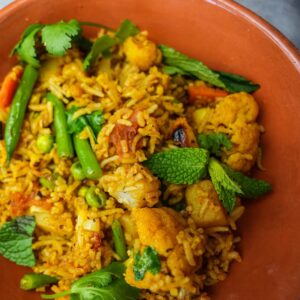
Hyderabadi Veg Biryani (Easy Restaurant Style Rice Recipe)
Equipment
Ingredients
- 1 cup aged basmati rice about 200 grams
- 1 tablespoon olive oil
- ½ teaspoon ground cardamom
- 5 whole cloves
- 1 ½ cups water
- 1 medium russet potato peeled and diced
- 1 small carrot peeled and cut into slices
- 3 tablespoons vegan butter
- 1 ½ cups cauliflower cut into small florets
- ⅓ cup raw cashews raw and unsalted
- 4 teaspoons minced green chili or to taste
- 7 strands saffron
- ½ teaspoon cumin seeds
- 2 teaspoons grated ginger
- 1 teaspoon turmeric powder
- 1 teaspoon Kashmiri red chili powder
- 10 curry leaves optional
- 1 cup chopped string beans
- 2 small tomatoes diced
- ½ cup frozen peas
- 1 ½ teaspoons rosewater
- ½ teaspoon salt
Optional Garnishes:
- Cilantro leaves
- Mint Leaves
Instructions
- Soak the rice for 20-30 minutes.
- Rinse the rice in a mesh strainer under running cold water to remove extra starch, and then allow it to drip dry.
- Heat a saucepan with 1 tablespoon of oil over a high flame.
- After 60 seconds when the oil is hot, fry the cloves and cardamom for 30 seconds.
- Add the drained rice and sautéed it stirring for 60 seconds to lightly toast the rice in the hot oil.
- Add water and cover. When the pot is boiling, reduce the flame to low and allow the rice to steam for 15-20 minutes until cooked, and all water has been absorbed.
- Meanwhile, in a separate pot over a high flame, boil diced potatoes and carrots until they are fork-tender (about 12-14 minutes)
- Drain the cooked potatoes and carrots in a colander.
- In a dutch oven heat the vegan butter over a high flame. Once the vegan butter has melted and is bubbling, sauté the cauliflower and cashews, stirring regularly for 3-4 minutes until they are lightly golden brown.
- Lower the flame to medium and stir in the chilies, spices, curry leaves, and ginger.
- After two minutes, stir in tomatoes and the pre-cooked potatoes and carrots. Sauté for 4 minutes, stirring over medium heat.
- Add peas and string beans. Sauté for 2 mins until the string beans are just tender.
- Mix in rice rosewater and salt. Make sure to break up any clumps of rice so that the veggies and seasonings are fully distributed, and the rice all becomes a lovely shade of yellow/orange.
- To serve, garnish with fresh cilantro (a.k.a. coriander leaves) and fresh mint leaves.
Notes
Soaking is essential!
Don't skip soaking and rinsing your rice if you want perfectly cooked biryani with separate grains. To achieve this, use high-quality aged basmati rice and soak it in cold water for 20-30 minutes, followed by rinsing until the water runs clear to remove excess starch. This will prevent the rice from being clumpy or stuck together.How to Cook Biryani in an Instant Pot:
Soak the rice: Soak basmati rice in cold water for 20 minutes. Rinse under cold water to remove excess starch. Allow it to drip dry. Prepare the rice in Instant Pot: Set Instant Pot to sauté mode. Heat 1 tablespoon of olive oil, then add cloves and cardamom. Fry for 30 seconds. Add drained rice and sauté for 60 seconds to lightly toast it. Add water, cover, and set to manual mode for 15-20 minutes until rice is cooked. Prepare veggies: Boil diced potatoes and carrots until fork-tender (12-14 minutes). Drain potatoes and carrots in a colander. Cooking in Instant Pot: In the Instant Pot, heat vegan butter. Sauté cashews and cauliflower until golden brown. Lower heat, add spices, chilies, curry leaves, ginger, and chilies. Sauté for two minutes. Add tomatoes, pre-cooked potatoes, and carrots. Sauté for 4 minutes. Add peas and string beans. Sauté for 2 minutes until string beans are tender. Mix in cooked rice, rosewater, and salt. Ensure even distribution. Serve: Garnish with fresh cilantro and mint leaves.
Enter your email & I'll send it to your inbox. Plus, get great new recipes from me every week!
By submitting this form, you consent to receive emails from Cinnamon Snail.

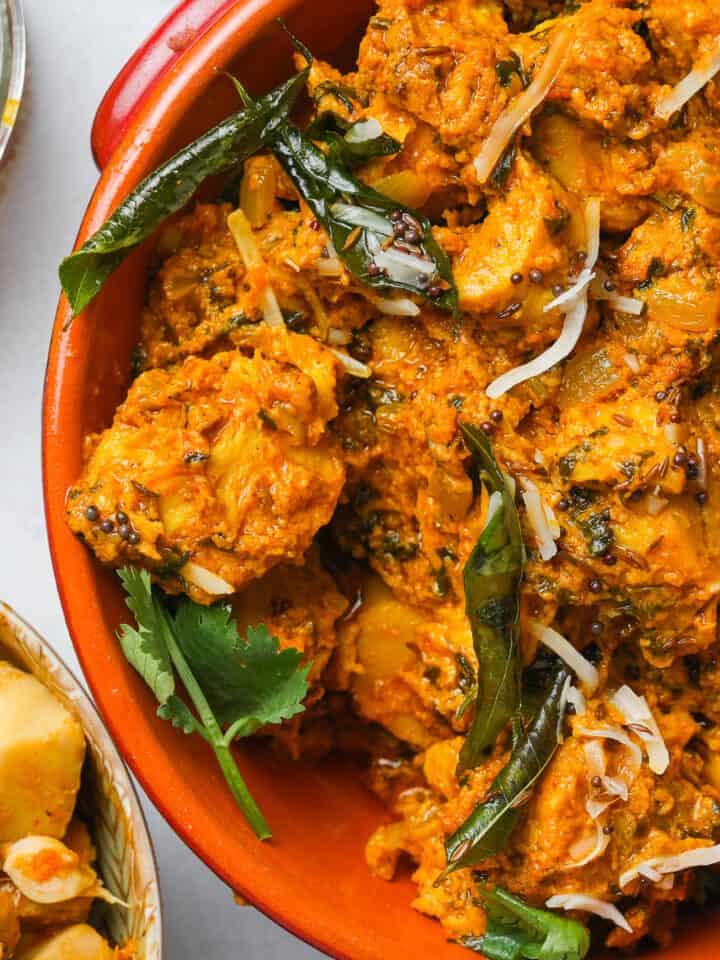
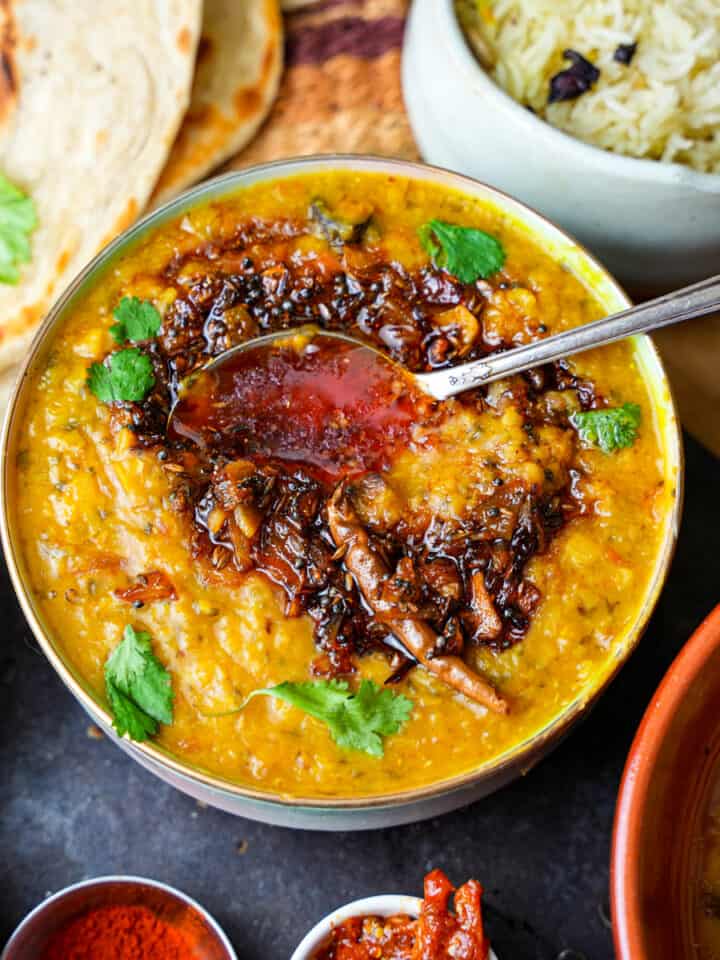
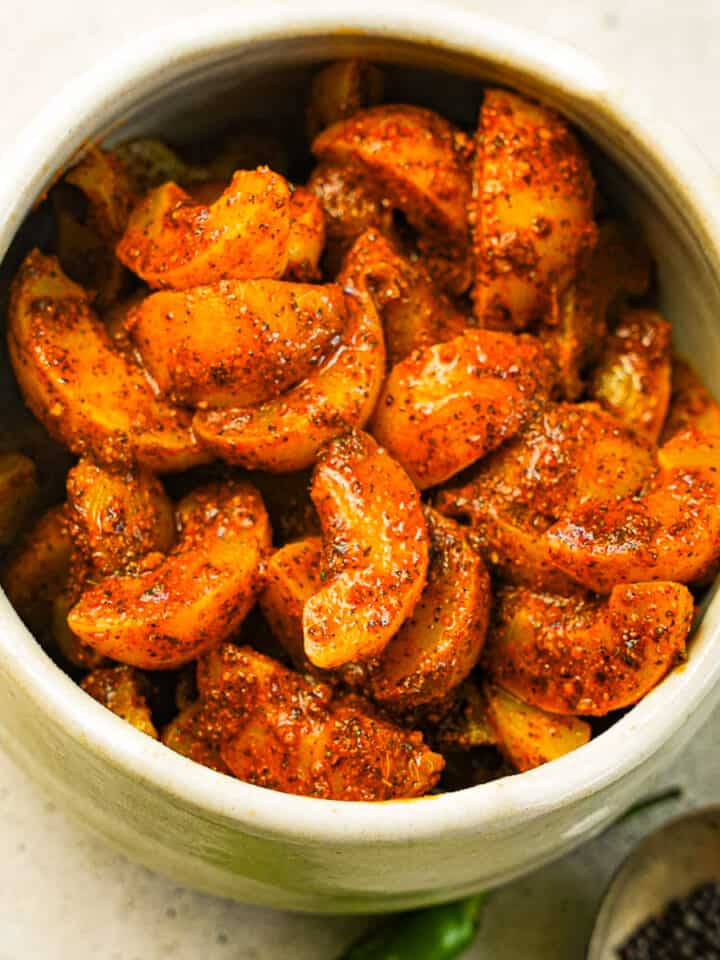
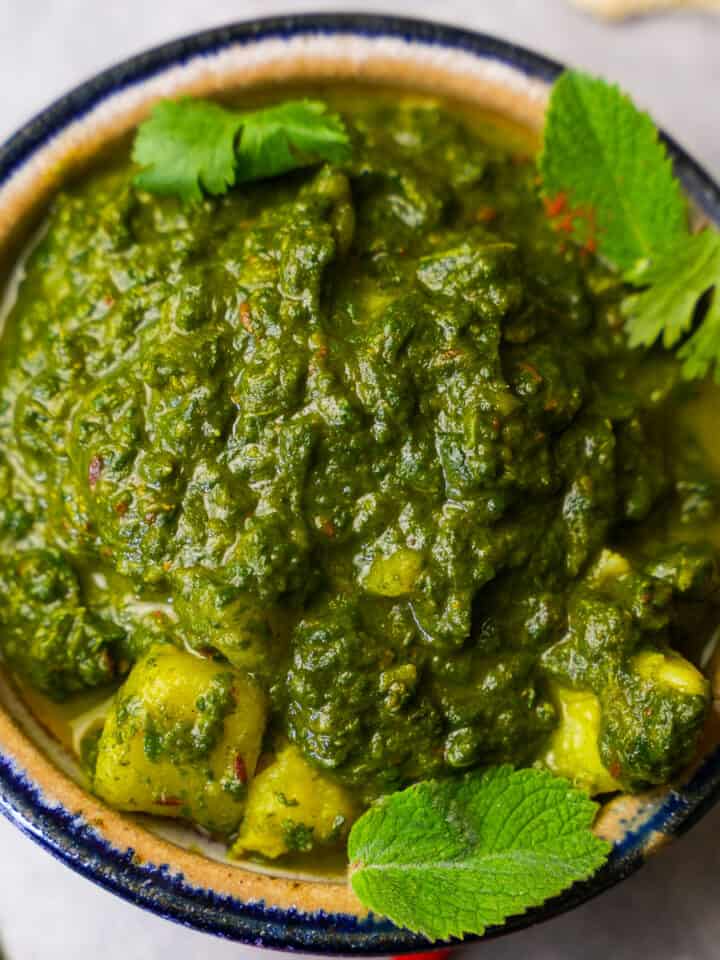




Meg says
This is freaking excellent. Really really worth doing. It a mouthful, the flavours are complex and simple and completely satisfying.
Thank you Chef Adam.
Michele says
I didn't use the green chili's, curry leaves or rose water because I didn't have them but it was still amazing. The whole family liked it and I will definitely make this again.
Liz says
This recipe was great with all the vegetables plus the cashews! And even though the rice was cooked with cloves and cardamom, those flavors are not overpowering. We really like the heat level of your recipe too. Between the chilies and the chili powder, it was perfect!
Cheryl says
Delicious and goes beautifully with the Butter Chicken !